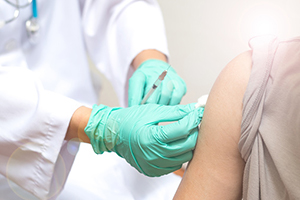In a study reported in The New England Journal of Medicine, Lei et al found that receipt of the quadrivalent human papillomavirus (HPV) vaccine among girls and young women was associated with a substantial reduction in the risk of invasive cervical cancer.
As stated by the investigators, “The efficacy and effectiveness of the quadrivalent HPV vaccine in preventing high-grade cervical lesions have been shown. However, data to inform the relationship between quadrivalent HPV vaccination and the subsequent risk of invasive cervical cancer are lacking.”

Photo credit: Getty
Study Details
The study involved data from nationwide Swedish demographic and health registers on 1,672,983 girls and women who were 10 to 30 years of age from 2006 through 2017. The population was followed for cervical cancer until their 31st birthday. The association between HPV vaccination and risk of invasive cervical cancer was analyzed controlling for age at follow-up; calendar year; county of residence; and parental characteristics, including education, household income, mother’s country of birth, and maternal disease history.
Key Findings
A total of 527,871 girls or women received at least one dose of the quadrivalent vaccine; 1,145,112 did not receive any doses of the vaccine.
Cervical cancer was diagnosed in 19 women who had received the vaccine vs 538 women who had not received the vaccine. The cumulative incidence of cervical cancer was 47 cases/100,000 persons in the vaccinated group vs 94 cases/100,000 persons in the unvaccinated group by 30 years of age.
Among women who initiated vaccination at the age of 17 to 30, the cumulative incidence was 54 cases/100,000 persons by the age of 30. Among women who had initiated vaccination before the age of 17, the cumulative incidence was 4 cases/100,000 persons by the age of 28.
In analysis adjusting for age at follow-up, the incidence rate ratio for the vaccinated vs unvaccinated population was 0.51 (95% confidence interval [CI] = 0.32–0.82). After additional adjustment for calendar year and residential and parental characteristics, the incidence rate ratio was 0.37 (95% CI = 0.21–0.57).
With stratification according to age at initiation of vaccination, the fully adjusted incidence rate ratios for cervical cancer were 0.12 (95% CI = 0.00–0.34) among women vaccinated before age 17 and 0.47 (95% CI = 0.27–0.75) among those vaccinated between the ages of 17 and 30. The fully adjusted incidence rate ratio was 0.36 (95% CI = 0.18–0.61) among women vaccinated before age 20 and 0.38 (95% CI = 0.12–0.72) among those vaccinated between the ages of 20 and 30.
The investigators concluded, “Among Swedish girls and women 10 to 30 years old, quadrivalent HPV vaccination was associated with a substantially reduced risk of invasive cervical cancer at the population level.”
Disclosure: The study was funded by the Swedish Foundation for Strategic Research and others. For full disclosures of the study authors, visit nejm.org.

